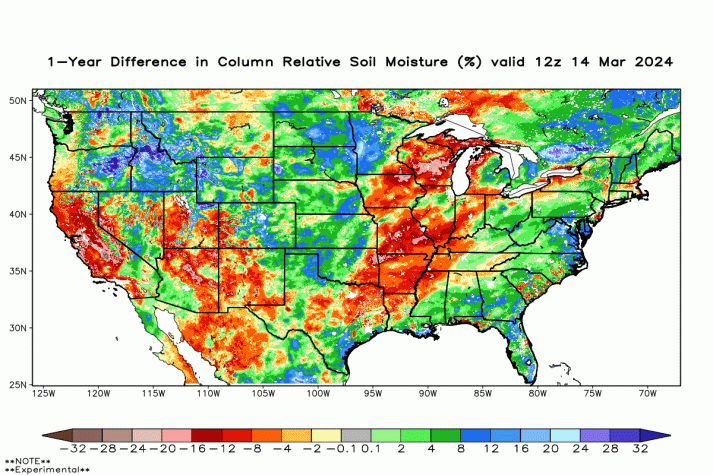Missouri soils now drier than start of 2023 planting season.
TROY, Mo. – Soils are much, much drier now than they were at the start of last year’s planting season, says University of Missouri Extension climatologist Zachary Leasor.
Despite gains in December and January, soil moisture sits below average for most of the state, Leasor says. Soil moisture plays an important role in the upper part of the soil but is even more important in the root zone.
“Compared to last year, soils are much drier this spring, and this leaves us vulnerable to rapid agricultural drought impacts if we don’t see above-normal precipitation over the next month,” says Leasor.
A map from the NASA Short-term Prediction Research and Transition Center gives the one-year difference in soil moisture from March 2023 to March 2024. It shows that almost all Missouri soils are seeing a major moisture deficit, even worse than at the start of 2023.
“The one-year change really sticks out to me given that, anecdotally, a lot of farmers felt that 2023’s drought came on so fast because we never fully recovered from 2022. With even drier conditions this spring, this is a major concern,” says Leasor.
Also, scattered, inconsistent precipitation means that one part of a farm could experience a greater lack of moisture than another part.
Knowing this, farmers may want to change their strategy as planting season nears, says MU Extension agricultural engineer Charles Ellis. Changes might help to prevent poor emergence and patchy germination.
Light spring tillage can prepare the seedbed in fall-tilled fields that became crusty or rough due to lack of precipitation, says Ellis. He recommends shallow tilling as close as possible to planting date to preserve soil moisture. Moisture loss from a light tillage pass can be recovered from a single rainfall.
For corn, wait until the soil warms to near 50 degrees before planting to encourage uniform seed germination and good stands that result in higher yields and better quality, he says. For producers with experience with no-till, consider no-till this year to minimize moisture loss from tillage and provide a mulching effect on the soil during the grow season.
Also, consider early termination of cover crops this year, says Ellis, a longtime member of the Midwest Cover Crops Council. Warmer temperatures have caused cereal rye and other cover crops to break dormancy earlier than usual. This new growth will pull water from the soil. During early April, a cover crop like cereal rye can use up to 0.8 inches of water per week, says Ellis.
Terminated cover crop residues can preserve moisture and act to insulate the soil. Cover crop residue also prevents rainwater from hitting the soil so hard and allows the water to gently move to the soil to reduce crusting. It also serves as a barrier to reduce evaporation.
Likewise, pay special attention to weed control this year, as weeds will compete for soil moisture.
Ellis recommends MU Extension’s “Evaluation of Herbicide Programs for the Termination of Cover Crop Species in the Spring” publication.
Make application when the cover crop is actively growing during sunny days.
As always, practice good stewardship of the soil, says Ellis.
